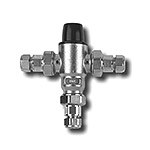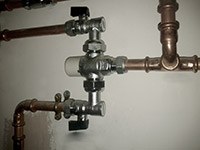
The impact of TMV’s on legionella control
Thermostatic mixer valves (TMV’s) are devices used to accurately control the temperature of water by blending hot and cold water to a set temperature between 38°c and 46°c to prevent the risk of scalding. Scalding can occur within seconds, especially with vulnerable users, installing TMV’s ensures water is provided at a safe temperature.
The most common way to prevent legionella bacteria is through the control of temperature within hot and cold-water systems. Hot water must be stored at above 60°c as this will kill off any legionella bacteria in the system, and hot water temperatures must reach 50°c at the outlets to manage the risk of legionella bacteria.
However, the problem of scalding arises at these temperatures, so this is where the two risks namely, legionella risk and scalding risk must be considered together, and a solution found.
Book TMV service now
 TMV’s are often used as a solution to prevent scalding but can themselves increase the legionella risk if not managed and maintained correctly.
TMV’s are often used as a solution to prevent scalding but can themselves increase the legionella risk if not managed and maintained correctly.
The water in pipework downstream of a TMV being less than 50°c could provide an environment in which legionella bacteria could multiply and therefore increase the legionella risk. So, it is important to ensure TMV’s are installed as close as possible (less than 2m) to the outlet to reduce the legionella risk, while also managing the scalding risk.
It is also important to consider whether the TMV is required, during the Legionella risk assessment the scalding risk will be compared to the legionella risk, if the scalding risk is considered insignificant then the TMV should be removed.
5 points to consider when fitting TMV’s:
- The TMV should be part of the tap fitting if possible, to mix the water at the outlet.
- The legionella risk will be increased if a TMV is fitted to a low flow spray tap.
- The TMV should be fitted as close (within 2m) as possible to the outlet to reduce the volume of stored water in the pipework.
- The legionella risk is increased if the TMV valve feeds more than one outlet, for example, a bank of showers or wash hand basins.
- A TMV can inadvertently make a cold tap become little-used outlet that will need to be flushed weekly.
The valves need to be checked on an annual basis or at a frequency defined by the risk assessment. It is important to ensure the valves are working correctly and will offer protection against scalding.
In hospitals, different regulations apply, and checks are bi-annual.
TMV servicing is typically grouped into batches so an entire site would be serviced rather than one individual valve which would be uneconomical.
As an example, annual servicing of 40 TMV’s at a large secondary school would cost between £25 to £29 per valve. This includes removal, service, and disinfection. We encourage customers to take advantage of our electronic logbook system which provides access in real time to view completed works and report on failed/passed valves and many other metrics. All valves are tagged with an individually numbered service tag to identify us and the year of service.
